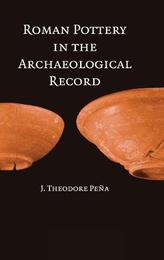
|
Roman Pottery in the Archaeological Record
Hardback
Main Details
| Title |
Roman Pottery in the Archaeological Record
|
| Authors and Contributors |
By (author) J. Theodore Pena
|
| Physical Properties |
| Format:Hardback | | Pages:458 | | Dimensions(mm): Height 234,Width 159 |
|
| Category/Genre | Ceramic arts, pottery, glass
Classical Greek and Roman archaeology
Pottery, ceramics and glass crafts |
|---|
| ISBN/Barcode |
9780521865418
|
| Classifications | Dewey:937 |
|---|
| Audience | | Professional & Vocational | |
|---|
| Illustrations |
12 Tables, unspecified; 9 Maps; 88 Halftones, unspecified; 32 Line drawings, unspecified
|
|
Publishing Details |
| Publisher |
Cambridge University Press
|
| Imprint |
Cambridge University Press
|
| Publication Date |
30 April 2007 |
| Publication Country |
United Kingdom
|
Description
This book examines how Romans used their pottery and the implications of these practices on the archaeological record. It is organized around a flow model for the life cycle of Roman pottery that includes a set of eight distinct practices: manufacture, distribution, prime use, reuse, maintenance, recycling, discard, reclamation. J. Theodore Pena evaluates how these practices operated, how they have shaped the archaeological record, and the implications of these processes on archaeological research through the examination of a wide array of archaeological, textual, representational and comparative ethnographic evidence. The result is a rich portrayal of the dynamic that shaped the archaeological record of the ancient Romans that will be of interest to archaeologists, ceramicists, and students of material culture.
Author Biography
J. Theodore Pena is Chair of the Department of Classics at the University at Buffalo, SUNY. A specialist in the archaeology of the Roman economy and ceramic analysis, he is the author of The Urban Economy in the Early Dominate: Pottery Evidence from the Palatine Hill and The Mobilization of State Olive Oil in Roman Africa: The Evidence of Late 4th Century Ostraca from Carthage.
Reviews'Pena's book is an essential study that needed to be carried out, and its author was ideally placed to undertake this task. ...we strongly recommend that Pena's rigourous work should become a component of the training of all field archaeologists and pottery specialists involved in the study of Roman sites. Antiquity
|